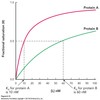Midterm 2 Flashcards
(171 cards)
What type of chaperone is GroEL–GroES?
chamber
Many diseases, including Alzheimer’s disease, are associated with
protein aggregation
Globular proteins are mostly ________ and fibrous proteins are mostly _________.
soluble
insoluble
Which fibrous protein is a myosin coiled-coil protein?
keratin
Describle keratin’s structure.
Left-handed coiled coil dimer
Right-handed helix
Disulfide bridges between 2 coiled coils
Which fibrous protein is the aa sequence (G-A-S) repeated and tightly packed?
Silk
Why does a Vitiman C deficiency cause scurvy?
Vitiman C is a cofactor for hyroxylase which hydroxylates proline forming HyPro. HyPro is a subunit of Collagen and the collagen deficiency causes scurvy.
Which fibrous protein is (HyPro-Pro-Gly) repeated?
Collagen
Protein folding is a ________ process.
spontaneous (exothermic)
What are chaperone proteins and what 3 functions of chaperones?
Proteins that facilitate the formation of stable 3D sturctures.
- Help proteins fold properly
- Fix misfolded proteins
- Disrupt aggregates
What are the 2 types of chaperone proteins?
- Clamp - heat shock
- Chamber -GroEL–GroES protein complex
What are the 3 Models of Protein Folding?
- Hydrophobic collapse - clustering of hydrophobic side chains
- Framework model - 2º/3º structures form independently
- Nucleation model - localized interactions between 2º stuctures
What are the 4 general steps involved in protein study?
- Cloning
- Expression
- Purification
- Characterization
What is the specific activity of a protein?
Total amount of activity of the target protein divided by the total amount of protein in the fraction.
Specific activity INCREASES with fractionization
As you centrifuge a cell, what are the 4 fractions you will get as you increase time and force (g)?
1st - Nuclear fraction
2nd - Mitochondrial fraction
3rd - Membrane fraction
4th - Cytosol fraction (Where most proteins exist)

What are the general steps to purify a protein?
- Centrifugation
- Salt Out
- Dialysis
- Chromatography
What is Salting Out?
Adding a salt (ammonium sulfate) to an aqueous protein solution and the salt molecules will bind the H2O molecules, freeing the protein of interest.
What is Dialysis?
Place (salt + protein) in a semi-permeable tube and place tube in a buffer solution. The salt will diffuse out, leaving protein of interest in tube.
*Note: It’s more effective to use several rounds small volume than one round large volume.

What are the various parts of an antibody? Label!
- antigen binding site
- light chain
- heavy chain
- variable domain
- constant domain
- disulfide bonds

How does column chromatography work?
- Separates proteins based on different physical/chemical interactions with a solid gel matrix.
- Proteins that interact poorly with the matrix are eluted first from the column.

How does gel-filtration chromatography work?
- Separates proteins based on size
- Large molecules elute first because they cannot fit through pores
- Smaller molecules elute last because they interact with beads
How does High-Performance Liquid Chromatography (HPLC) work?
- Separates proteins based on size (same as gel-filtration)
- Contains smaller bead particles leading to better separation
Requires Applied Pressure
How does Ion-Exchange Chromatography work?
- Separates proteins based on charge
- Positively charged anion matrix Diethylaminoethyl (DEAE)
- Negatively charged cation matrix Carboxyl methyl cellulose (CMC)

How does Affinity Chromatography work?
- Ligand is covalently linked to beads and proteins stick to the ligand










































































